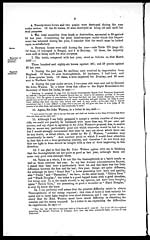Medicine - Veterinary > Civil Veterinary Departments > Annual administration report of the Civil Veterinary Department of India > 1896-1897 > Part I - Imperial report
(19) [Page 1]
Download files
Individual page:
Thumbnail gallery: Grid view | List view
![(3) [Page 1] -](https://deriv.nls.uk/dcn17/7550/75503559.17.jpg)
GOVERNMENT OF INDIA.
ANNUAL ADMINISTRATION REPORT
OF THE
CIVIL VETERINARY DEPARTMENT IN INDIA
FOR THE OFFICIAL YEAR
1896-97.
PART I.-IMPERIAL REPORT.
A.—MILITARY SECTION.
I.-HORSE BREEDING.
Stallions.
Number of.
As will be seen by Table I (page iii), the number of stallions at the
commencement of the year was 361. Seventy-eight were added to the
Register, and 53 were struck off, leaving a balance of 386 on 31st March 1897.
Of this number:—
|
72 were employed in North-Western Provinces and Oudh. |
||
|
175 „ |
„ |
„ Punjab. |
|
42 „ |
„ |
„ Baluchistan. |
|
5 „ |
„ |
„ Central India. |
|
2 „ |
„ |
„ Rajputana. |
|
47 „ |
„ |
„ Bombay. |
|
43 new horses remained unallotted. |
||
This year, the unacclimatized horses that remained unallotted, are
enumerated separately, so as to show the numbers that were actually available.
Received
during the year
2. Thirteen Australians and 20 Arabs were purchased by me in India, and
24 horses, including thoroughbred English, half and three-quarter breds, and
hackneys, were received from England.
Casualties.
3. As will be seen by reference to Table II (page iv), 15 stallions died
during the year, giving a percentage of 4.15. The death-rate shows an average
of about 5 per cent. in all Provinces except in South Punjab, where it was only
3.52 per cent. The highest death-rate, as usual, occurred in Baluchistan.
Were it not for abdominal disease, the death-rate would be but trifling,
but in Baluchistan, where all stallions are fed on bhoosa and lucerne, it is only
natural to expect that diseases of this nature will be very prevalent. Although
the general death-rate is higher than I could wish, still, I consider that the
Department has been fortunate in not losing more stallions, as, owing to the
great drought, the horses had to exist on the worst possible grass; in fact, at
one time it was thought that it would be necessary to remove many of the
horses from the stands to the depôts. The great heat which existed in July,
accounted for two deaths, whilst anthrax accounted for the same number. The
Department was unfortunate in losing the thoroughbred English stallion
"Millom," and thoroughbred Australian "Nulquine;" both of these suc-
cumbed to the excessive heat in July; they were good stockgetters. Also in
losing the thoroughbred English stallion "Ottoman" and the thoroughbred
Australian "Donation," both of which were stallions that promised exceeding
well; the latter being by "Martini Henry" by "Musket."
B
Set display mode to: Large image | Zoom image | Transcription
Images and transcriptions on this page, including medium image downloads, may be used under the Creative Commons Attribution 4.0 International Licence unless otherwise stated. ![]()
| India Papers > Medicine - Veterinary > Civil Veterinary Departments > Annual administration report of the Civil Veterinary Department of India > 1896-1897 > Imperial report > (19) [Page 1] |
|---|
| Permanent URL | https://digital.nls.uk/75503557 |
|---|




